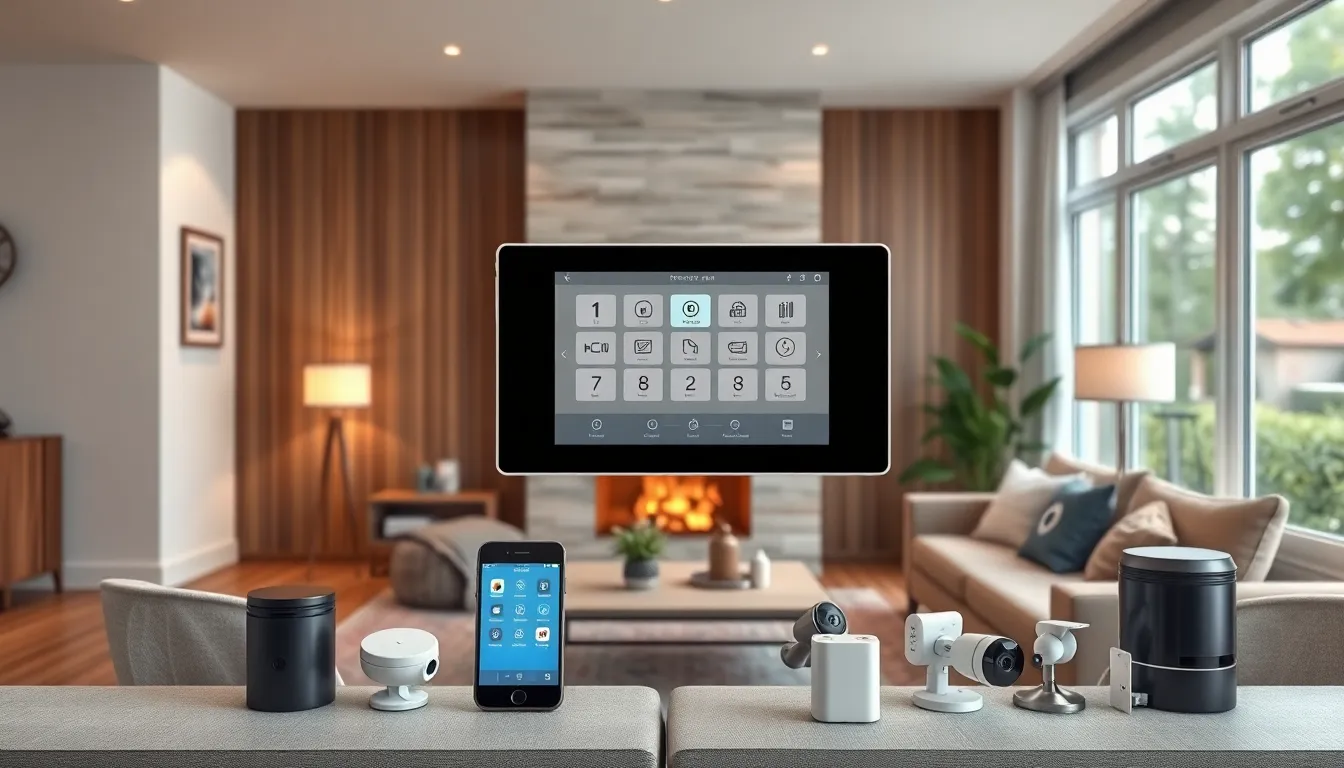In a world where even your neighbor’s cat seems to have a security system, finding the best home security system can feel like searching for a needle in a haystack. With options galore, how do you pick the one that’ll keep your castle safe from unwanted visitors—human or feline? Fear not! The right system can turn your home into a fortress without sacrificing style or comfort.
Imagine a system so smart it knows when you’re home and when you’re not, all while making you feel like a tech-savvy superhero. From doorbell cameras that catch every suspicious squirrel to motion sensors that alert you faster than your coffee can brew, the best home security systems have it all. Let’s dive into the top contenders that’ll keep your home secure and give you peace of mind, so you can focus on more important things—like perfecting your Netflix binge-watching skills.
Table of Contents
ToggleOverview of Home Security Systems
Home security systems play a critical role in protecting residences. Various types of systems exist, offering different features designed to enhance safety. Basic options include alarms that sound when triggered, while advanced systems incorporate smart technologies like mobile notifications and remote access.
Smart technology provides homeowners with real-time updates, enabling them to monitor their properties from anywhere. Security cameras equipped with motion detection enhance surveillance efforts. Doorbell cameras allow for communication with visitors, even when no one is at home.
An integrated system ensures seamless operation among devices. Wireless setups minimize cumbersome installations, offering flexibility in placement. Choosing a system tailored to specific needs involves considering budget and preferences. Many systems are customizable, allowing homeowners to adjust features based on lifestyle and security requirements.
Monitoring services add another layer of protection. Professional monitoring typically includes rapid response to alerts. Some options allow for self-monitoring, where homeowners receive notifications directly on their smartphones.
Cost varies across different security systems. Basic systems generally start around $200, while comprehensive setups can exceed $1,000. Monthly monitoring fees range from $15 to $60, depending on the level of service.
Installation methods differ as well. DIY options simplify setup processes, but professional installation guarantees optimal efficiency and effectiveness. Encouraging a thorough review of system functionalities aids in selecting the best fit for individual needs.
Understanding the array of security systems available allows homeowners to make informed decisions. Prioritizing safety features and technological advancements contributes to creating a secure environment, providing peace of mind.
Features to Consider

Home security systems offer various features essential for effective protection. Key features focus on monitoring options and smart home integration.
Monitoring Options
Various monitoring options enhance home security systems. Professional monitoring provides 24/7 supervision. This service often includes alerts via phone or text during emergencies. Self-monitoring, on the other hand, enables homeowners to control the system remotely using mobile apps. Owners can receive notifications when sensors are triggered. Each option has distinct advantages. Budget considerations play a crucial role. Many systems present tiered pricing for different monitoring packages, catering to a variety of financial needs.
Smart Home Integration
Integration with smart home devices elevates security systems. Compatibility with platforms such as Amazon Alexa or Google Assistant allows for voice control. Homeowners can arm or disarm systems hands-free. Smart locks enhance security further, providing keyless entry and remote access. Cameras can deliver live feeds directly to smartphones or tablets, allowing for real-time viewing. Automating security functions, like scheduling lights to simulate presence, helps deter intruders. Ultimately, seamless integration maximizes both security and convenience for users.
Top Picks for Best Home Security System
Choosing the right home security system ensures optimal protection for a residence. Here are three top systems, each featuring unique advantages.
System 1: Overview and Features
The first system offers comprehensive coverage, including indoor and outdoor cameras. It features a user-friendly mobile app, enabling real-time monitoring from anywhere. Custom alerts notify homeowners of unusual activity, while two-way audio enhances communication with visitors. Compatibility with smart home devices allows seamless integration with existing setups. Installation options include DIY and professional assistance, catering to different preferences.
System 2: Overview and Features
Next, this security system excels in robust monitoring and smart automation. It includes motion sensors that detect movement and send immediate alerts to owners. A built-in siren activates during breaches, deterring intruders effectively. Homeowners enjoy the convenience of remote access through a mobile app, enabling them to control settings while away. Subscription plans offer various monitoring services, ensuring adaptability based on individual needs.
System 3: Overview and Features
The third system emphasizes advanced technology and reliability. High-definition video capabilities provide clear surveillance, while night vision ensures visibility after dark. Users benefit from cloud storage for video footage, allowing easy access to recordings. This system integrates with popular voice assistants, facilitating hands-free operation. Monthly costs remain competitive, making it a budget-friendly choice for many households.
Installation and User Experience
Choosing the right home security system includes evaluating installation and user experience. Many systems offer simple DIY installation options, allowing homeowners to set up their security without professional help. Others require the expertise of a technician. Professional installation generally ensures proper setup and optimization of device features.
User interfaces play a significant role in overall satisfaction. Mobile apps provide functionalities like remote monitoring, adjusting settings, and receiving notifications. Systems with intuitive navigation facilitate ease of use for all family members. Operations, such as arming or disarming alarms, should take only a few taps, enhancing user experience.
User feedback often highlights the importance of seamless integration. Systems that connect easily with existing smart home devices enhance overall functionality. Compatibility with voice-controlled platforms typically simplifies the management of multiple devices. In addition, automation features enable users to schedule routines, such as turning on lights or locking doors.
Homeowners experience increased peace of mind with real-time notifications. Alerts for motion detection or doorbell activation keep them informed about activity around their home. Customizable settings enhance the experience by allowing users to tailor notifications to their preferences.
Support services can also impact user satisfaction. Accessible customer support provides assistance for any installation challenges or system questions. Reviews of top systems frequently mention responsive service as a factor influencing overall satisfaction. Ultimately, a combination of straightforward installation, user-friendly interfaces, and excellent support enhances the home security experience.
Cost and Value Comparison
Selecting a home security system involves balancing cost and value. Systems range from basic setups starting around $200 to advanced installations exceeding $1,500. Budget constraints often dictate choices.
Monthly monitoring fees contribute significantly to the overall cost. Professional monitoring services typically charge between $15 and $50 per month, while self-monitoring options can incur minimal to no fees. These costs impact long-term investments in security.
Analyzing features clarifies how each system delivers value. For example, systems with smart home integration offer added convenience, which justifies higher price tags. Basic systems focus solely on alarms, sacrificing advanced technology for lower costs.
User experience also affects perceived value. Systems with intuitive interfaces often prompt higher customer satisfaction. Seamless mobile app connectivity enhances monitoring capabilities, making them worth the investment for many users.
Varied installation methods provide additional considerations. DIY installations usually save costs but may require more user effort. Professional installations ensure optimized setups, enhancing effectiveness even at a higher price.
Long-term savings emerge from choosing reliable systems. Investing in high-quality products might reduce maintenance costs and increase lifespan. Affordable systems may initially appear enticing but can incur additional expenses over time.
In summation, weighing costs against potential value leads to informed decisions. Prospective buyers should prioritize features, installation methods, and monitoring options. Each element contributes to overall satisfaction and security effectiveness, aiding in selecting an appropriate system.
Selecting the best home security system is a crucial step toward ensuring peace of mind. With a variety of options available homeowners can find a system that meets their specific needs and fits their lifestyle. Whether opting for advanced smart technology or a simpler setup the right choice can provide effective protection and enhance convenience.
Prioritizing features like monitoring options and smart home integration can lead to a more satisfying user experience. By evaluating costs and understanding the value each system offers individuals can make informed decisions that safeguard their homes. Ultimately investing in a reliable home security system allows homeowners to focus on what truly matters in their lives.


